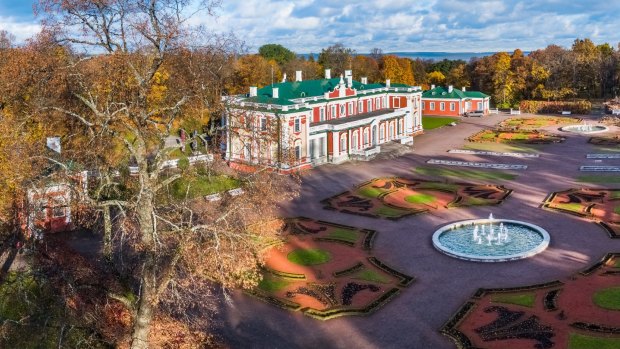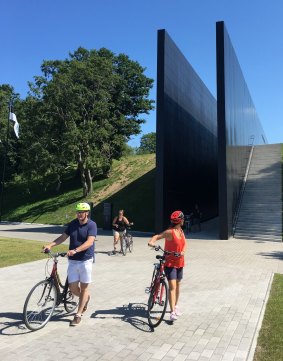This was published 4 years ago
Tallinn, Estonia: How to escape its tourist-choked heart
By Rob McFarland

Kadriorg Palace Credit: Tallinn City Tourist Office & Convention Bureau
Travel is a constant tug of war between anticipation and reality. Which inevitably means you'll occasionally visit somewhere that falls short of your expectations. Sadly, Tallinn in Estonia is one of those places. It's the last stop on an 11-day Intrepid Travel trip through the Baltics and I'd read lyrical reviews about its World Heritage-listed Old Town, one of the best-preserved medieval centres in Europe.
It's certainly quaint – a photogenic montage of cobbled streets, gothic spires and pastel-hued merchant houses. However, a cast of costumed tour guides, spruiking beer "wenches" and drunken buck's parties lend it the air of a medieval theme park. To be fair, I'm here on a busy weekend in summer – I'd imagine it's much less Disney-fied on a frigid Tuesday in February.
In search of a more authentic experience, I join a cycling tour with City Bike, figuring I'll have more chance of learning about the city's history if I venture outside its tourist-choked heart.

A memorial to the victims of communism.Credit: Rob McFarland
After leading us out of the walled city centre, Lea, our young Estonian guide, provides a potted summary of her homeland's turbulent past. After being ruled by the Danish, Polish, Swedish and Russians, the country enjoyed a brief stint of independence from 1918 before the Russians invaded again in 1940. The following year the Nazis moved in, but not for long, because the Soviets regained control in 1944.
"For us, there has not been much liberation," she says, with characteristic Baltic understatement.
We cycle through the busy port, past a flotilla of ferries bound for Helsinki, less than 90 kilometres away. Lea explains that Estonian and Finnish are closely related – every noun in both languages has more than a dozen forms, making them fiendishly difficult for foreigners to master.
Our next stop is Kadriorg Park, a verdant 70-hectare haven built by Russian Tsar Peter the Great for his wife Catherine I. At its heart is Kadriorg Palace, a handsome 18th-century pink edifice with a delightful French-style formal garden and an impressive collection of European and Russian artworks.
Equally grand is the nearby Presidential Palace, which since 2016 has been the home of Kersti Kaljulaid, Estonia's youngest and first female president. The entrance is permanently flanked by two rifle-bearing guards, an assignment that must be particularly gruelling in winter when the temperature can plunge to minus 20 degrees.
Leaving the park, we head towards the Song Festival Grounds, a purpose-built amphitheatre used for the country's popular song festival. Singing became one of Estonia's main forms of protest during the Soviet era and on September 11, 1988, an estimated 300,000 people gathered here to sing patriotic hymns. The following year, about 2 million people joined hands to form the Baltic Way – a 600-kilometre-long human chain from Tallinn to Vilnius.
"We gained independence without warfare," says Lea, "by singing and holding hands."
Our last stop is a pair of memorials that reflect Estonia's tumultuous past. The first is a neglected Soviet-built complex with a controversial 35-metre-high obelisk dedicated to the Soviet troops who died invading Estonia in 1918. Of greater architectural appeal – and arguably more justified – is the nearby Memorial to the Victims of Communism. Completed in 1988, it commemorates the hundreds of thousands of Estonians who suffered under Soviet rule. Comprising a striking installation of 22,000 metal bees (one for each person killed between 1940 and 1991) plus a towering pair of jet-black walls bearing their names, it's a poignant reminder of the brutal and often senseless tragedies inflicted by communism.
As we cycle back along the seafront towards the Old Town, past locals sunbathing on the beach, my perspective shifts. I realise that if I'd spent most of my life fighting for independence against a brutal regime, I'd want to enjoy my newfound freedom, too. And if that meant plying gullible tourists with costumed tours and medieval fare over the summer, I could live with that.
TRIP NOTES
MORE
TOUR
City Bike's two-hour Welcome to Tallinn tour departs every day at 11am and costs €21. See citybike.ee/en
VISIT
Intrepid Travel's 11-day Northern Poland and the Baltics trip visits Poland, Lithuania, Latvia and Estonia and includes stays in Vilnius, Riga and Tallinn. From $2886 per person. See intrepidtravel.com
Rob McFarland was a guest of Intrepid Travel.
Sign up for the Traveller Deals newsletter
Get exclusive travel deals delivered straight to your inbox. Sign up now.